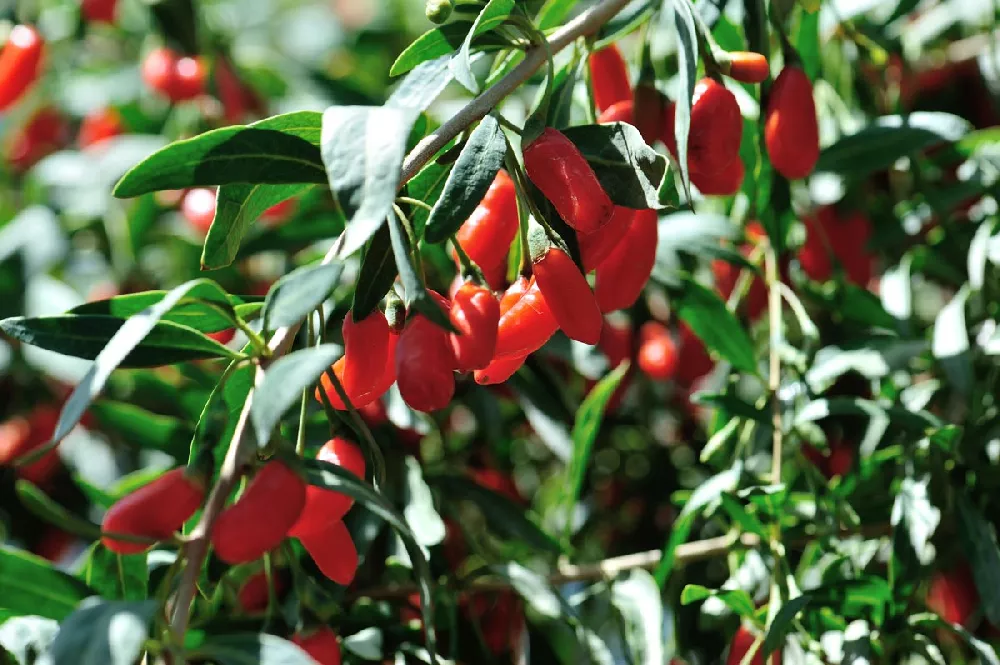Goji Berry Plant for Sale - Buying & Growing Guide
- Ships in 1-2 days
- 1-Year Warranty Eligible
- Pots or accessories are not included unless specified in the product options.
Shipping Details:
Once your order is shipped, you’ll receive an email with a tracking number and estimated delivery date. Most orders ship immediately, but some items are seasonal and may only ship in spring or fall. These products are noted on the website.
Goji berry plants, Lycium barbarum, have gained in popularity as word of their health benefits has spread. These powerhouse berries are packed with antioxidants, vitamins, iron, and fiber, and they have been used to treat everything from high blood pressure to age-related illnesses. They become sweeter when dried, and they can be eaten fresh or used in cooking and baking. The goji berry plant, which is also known as Chinese boxthorn or wolfberry, is a simple-to-grow bush that can easily find a place in your landscape. Here are a few more reasons to plant a goji berry bush today:
- The goji berry plant is highly disease-resistant and needs no regular spraying of chemicals.
- Once established, they are drought-resistant and need little supplemental watering.
- A mature plant can produce nearly 7 pounds of fruit a year when the conditions are right.
Plant Care
Sunlight
The goji berry plant can tolerate some shade, but it grows best with six or more hours of direct light a day.
Watering
Water daily when newly planted. Taper back once established, when your goji berry plant will only need water in dry conditions.
Fertilizing
Instead of using chemical fertilizers, dress your plant with well-rotted compost or manure annually.
Planting and Care
Planting instructions
Your goji berry plant is best sited on soil that drains well and in a spot that receives six or more hours of sunlight a day. Unpot your bush and tease out any encircling roots, which can girdle the plant and kill it. Dig a hole that’s a little deeper than the root ball and twice as wide. Mix several shovelfuls of well-rotted compost or manure in the hole, placing the bush on top. Holding it steady and upright, fill in around your bush with topsoil that’s been mixed with compost or manure, tamping down as you go to eliminate air pockets. Water thoroughly. Apply a 2- to 3-inch layer of an organic mulch, such as bark chips, around the bush’s root zone to help conserve water and deter weeds.
Watering and nutrients
Water newly-planted goji berry bushes daily for a month following planting. You should begin to see some robust growth by that time. When you do, taper back on watering to once or twice a week. After the first year, your goji berry plants should only need supplemental watering in very hot or dry weather — a good rule of thumb is to be sure they have 1 inch of water a week. To provide your goji berry plant with nutrients, pull back the mulch in spring and top dress with a layer of aged manure or compost. You may also use a fertilizer designed for landscape plants if you prefer.
Pollination
Goji berry plants are self-fertile, which means the male and female reproductive organs appear on the same plant. What that means for you is that you can have a harvest of the berries even if you only own one plant. It’s worth noting, however, that your harvest will likely be considerably larger if you have two or more plants near each other. The goji berry plant has purple flowers in the spring that are pollinated by insects.
Pruning
Prune your goji berry plant in early spring. First prune out any dead, diseased, or damaged limbs, cutting back to healthy wood. Goji berry plants fruit on wood from the previous year, so you can help achieve a full harvest by cutting back some of the oldest stems each year — especially those that are 3 or more years old. If your goji berry plant gets too tall, prune it back to a manageable height. You may also prune out some stems in the center of the bush to let in light and air and keep it from getting too crowded.
Pests, diseases, and animals
Goji berry plants are generally disease- and pest-free. Occasionally you may see aphids, Japanese beetles, or spider mites on your bushes. A healthy plant can repel most infestations, but keep the ground debris-free around your plant and use an insecticidal soap if necessary. Diseases that may occur include anthracnose and blight, both of which are fungal in nature. Avoid overhead watering and make sure you plant your trees far enough apart so that air can circulate between them. When the berries are ripe, you may have some competition for them from birds. Netting the bush is one way to handle it.
Harvesting
Goji berries ripen in the early to mid summer. You’ll know they are ripe when they turn a vivid red and taste sweet. If they’re truly ready, they can be picked easily off the bush. Harvest the berries by hand, and store them in a cool location until you are ready to use them.
Achieving maximum results
Goji berry bushes have a tendency to flop over when they get to a certain height, but you can minimize this by staking them. Place a sturdy wooden or metal stake, at least 6 feet tall, in the soil next to the trunk. Loosely tie the strongest canes to it so that they have some room, but not enough to flop. Prune out the weaker canes. Be careful and remember to wear gloves and long sleeves, because goji berry plants do have thorns.
FAQs
Can I grow a goji berry bush in a container?
Yes, you can. Pick an ornamental container with drainage holes in the bottom that is roughly twice the size of the root ball. Keep your plant outside during the spring and summer, but bring it inside during the winter if you live north of USDA hardiness zone 5. Keep an eye on your plant's watering needs — a container-grown plant will dry out more quickly than one planted in the garden.
How big will my goji berry plant get?
When grown outside in the garden, a goji berry bush can top out at 8 to 10 feet in height, but you can control the height with light pruning in the spring. The width of a mature Goji Berry is 4 to 6 feet, so if you are planting multiple bushes, space them at least 6 feet apart.
How long do goji berries keep after they've been picked?
Once you've harvested your goji berries, you can store them in your refrigerator or another cool spot for up to one week. They also freeze well, and they can be stored in the freezer for up to six months. If you have more than you need for fresh eating, consider drying them in a dehydrator or low oven, then storing them in a jar in a cool spot — much as you would with raisins.
Compare Similar Products
Customer Reviews
Goji berry was received by Very good condition. Thank you!
You can't add more Product Name - Product size to the cart.
OK








